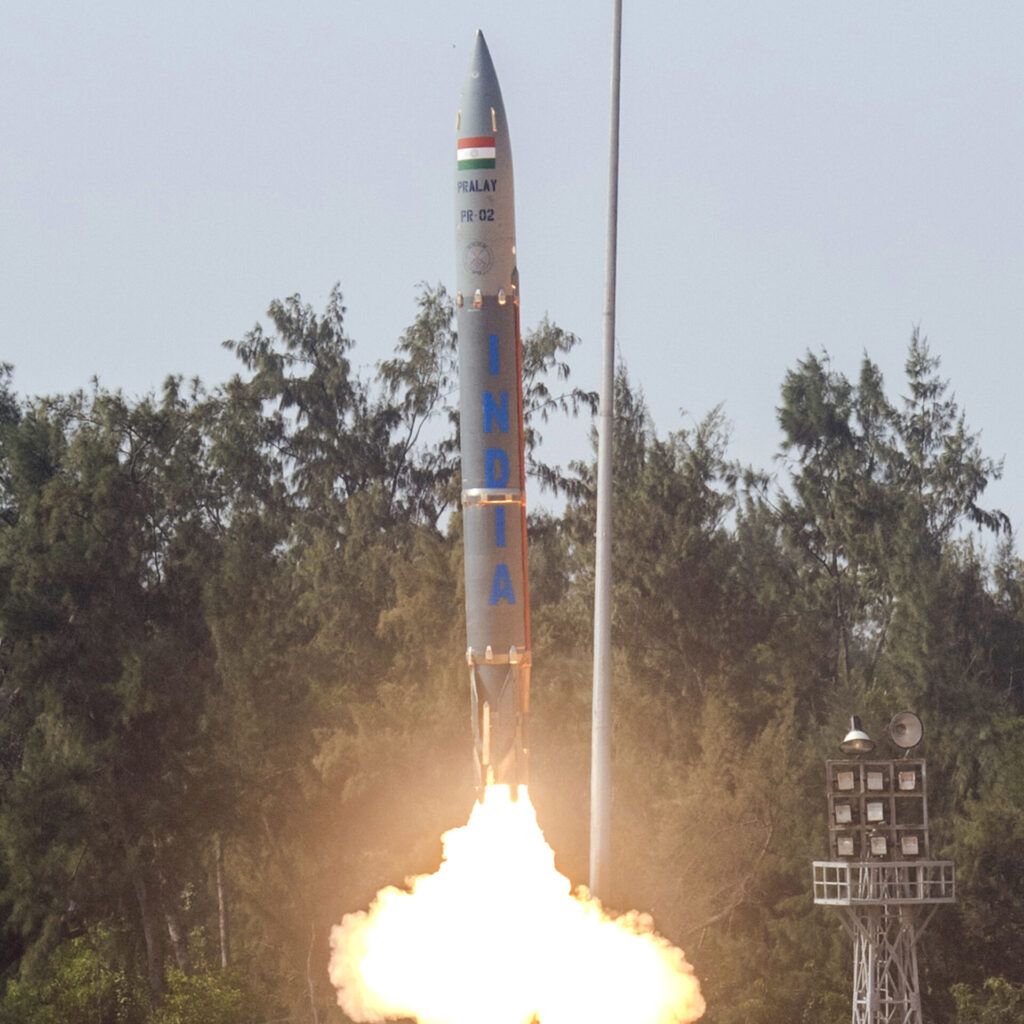How India’s restructured rocket force makes conflict with China more likely
By Debak Das | April 22, 2024
 The Pralay ("apocalypse") short-range ballistic missile (seen here during a launch test in 2021) reportedly forms a major part of India's new Integrated Rocket Force. (Credit: DRDO / Government of India)
The Pralay ("apocalypse") short-range ballistic missile (seen here during a launch test in 2021) reportedly forms a major part of India's new Integrated Rocket Force. (Credit: DRDO / Government of India)
On March 11, 2024, the Indian government announced that it had successfully tested an Agni-V ballistic missile with multiple independently targetable reentry vehicle (MIRV) technology. According to India’s Defence Research and Development Organisation, multiple reentry vehicles were tracked during the test. Discussions are now taking place as to what this new development means for India’s nuclear strategy and how it will impact India’s relations with China—the country against which this technology is most probably aimed at.
India’s test of MIRV technology on the Agni-V missile shows that it is making qualitative technological advances in its ability to target China. New Delhi’s initial set of nuclear-capable ballistic missiles and other delivery systems were aimed at Pakistan. Over the last decade, however, India’s advances in nuclear and conventional military capabilities have aimed to tackle the threat from China. With the Agni-V missile’s reported range of 5,000 kilometers—making it an intermediate-range ballistic missile, even though Chinese officials have claimed its actual range is closer to 8,000 kilometers, which would make it an intercontinental ballistic missile—India has signaled its ability to target all of China’s mainland. The MIRV capability will qualitatively boost this capability.
Both India and China have a nuclear no-first-use policy. This means that they have committed not to use nuclear weapons first against an adversary. But India’s MIRV capability indicates that it could have a greater ability to conduct a massive first strike that could bypass missile defenses with multiple warheads and decoys if it ever chooses to abandon its no-first-use policy.
For India, such a strategy may be more tempting to use against Pakistan in order to establish escalation dominance at all levels of conflict as well as the allure of attempting a disarming first strike against Islamabad’s smaller nuclear force. However, more likely, India might aim to use this technology to secure and strengthen its second-strike capability against China. Its MIRV test signals that if India were to be attacked first, New Delhi would still have a good number of warheads miniaturized and dispersed on road, rail, and sea-mobile delivery systems to potentially inflict unacceptable damage to China in a retaliatory strike. India’s eventual deployment of MIRV-ed ballistic missiles could also seek to nullify China’s recent advances in missile defense as indicated by reports of a successful ground-based mid-course missile interception test. Ultimately, India’s sea-based ballistic missiles—loaded on the nuclear-powered submarine INS Arihant and three other such planned ballistic missile-carrying nuclear-submarines—will be the mainstay of its second-strike capability. MIRV-ed sea-launched ballistic missiles will bolster the Indian Navy’s ability to have “continuous-at-sea-deterrence” capacity, aimed at possessing a nuclear force that might survive a nuclear first strike.
India’s development of MIRV technology, however, should not be viewed in isolation.
MIRVs ought to be considered alongside India’s development of its proposed Integrated Rocket Force, a conventional missile force that will contain both short- and long-range cruise and ballistic missiles. The short-range Pralay ballistic missile with a range of 150 to 500 kilometers will reportedly form a major part of this rocket force, which is being raised with the aim of targeting China. Strategic stability between India and China at the nuclear level—with a secure second-strike provided by MIRV-ed nuclear-armed missiles—will create space under the nuclear threshold for conventional military exchange and escalation. Greater strategic stability in the Sino-Indian relationship could therefore considerably increase the risk of escalation at lower levels of conflict. For example, India’s Integrated Rocket Force could be used to target Chinese conventional forces along the Line of Actual Control that marks the contested border between the two countries.
Indian and Chinese troops have clashed multiple times already at different points along the Line of Actual Control in recent years. Beijing has built considerable infrastructure on the Chinese side and frequently tests the Indian military by entering the Indian side of the demarcation line. India, meanwhile, has increased its ability to respond to China by raising divisions of its Mountain Strike Corps. New Delhi expects more clashes with China at low levels of escalation along the 2,100 mile-long contested boundary in the Himalayas.
Strategic stability at the nuclear level will likely create space for India to use its Integrated Rocket Force at the conventional level. This will allow it to target Chinese forces and infrastructure in specific theaters along the Line of Actual Control with conventional rockets and short-range cruise and ballistic missiles.
How China will respond to India’s qualitative changes to its nuclear and conventional forces is still unknown. China does not view India as a peer competitor in the nuclear and missile arena. Though China’s vulnerability to India’s strategic missile forces has increased, Beijing continues to maintain a numerical and qualitative edge over New Delhi in nuclear weapons delivery capability. China’s strategic posture vis-à-vis India is unlikely to change any time soon because the asymmetry in Sino-Indian strategic relations remains unchanged despite India’s MIRV capability. An opinion piece published in the Global Times a day after India’s Agni-V test argued that “there are still huge gaps, even generational gaps, between India and other major powers such as the US, China and Russia in terms of missile capabilities.” The point reinforced here was that for Beijing, China’s competitor is the United States, not India. Nevertheless, China continues to monitor India’s missile advancements. This was demonstrated by its overt deployment of a “research vessel” in the Bay of Bengal to track India’s MIRV test.
India’s MIRV capability is in its early stages and is unlikely to rock the boat of Sino-Indian strategic stability right away. New Delhi’s short announcement about its MIRV test did not disclose details of how many reentry vehicles were tested, nor whether they were just multiple reentry vehicles with decoys or whether these vehicles were all indeed independently targetable. More details would need to emerge before China or any other adversary considers this advancement to be a significant threat.
Ultimately, the main concern for Sino-Indian relations after the MIRV test and the purported solidifying of strategic stability is the space that this will open for conventional crisis escalation. Should the Indian Integrated Rocket Force and the Chinese People’s Liberation Army Rocket Force engage in conventional missile exchanges during a border crisis, neither side might be able to prevent the eventual escalation of hostilities up to the strategic level.
Together, we make the world safer.
The Bulletin elevates expert voices above the noise. But as an independent nonprofit organization, our operations depend on the support of readers like you. Help us continue to deliver quality journalism that holds leaders accountable. Your support of our work at any level is important. In return, we promise our coverage will be understandable, influential, vigilant, solution-oriented, and fair-minded. Together we can make a difference.















China has long held a no first use nuclear policy but their recent global governance policy does not explicitly mention no fist use. This could be a change in decades old policy
Very unlikely, because India straddles east-west with Russia significantly moderating Chinese behavior vis-a-vis India while the United States is the principal blocking force behind any expansionary move by China. On the other hand, India is the potential predatory power in any United States-and-allies/China high-speed collision that China has to worry about.
MIRV is an old technology. Even Pakistan has it. I wonder why it took so long for India to develop it. As mentioned in the article both India and China have renounced first use of nuclear weapons. But the US and Pakistan have asserted their right for using nuclear weapons first if they want to. Looking at what is happening in Ukraine and Gaza, it is clear that powerful countries can do whatever they want irrespective of international opinion. They don’t mind bombing and destroying the weaker countries out of existence. Might is right appears to be the unaccepted truth.